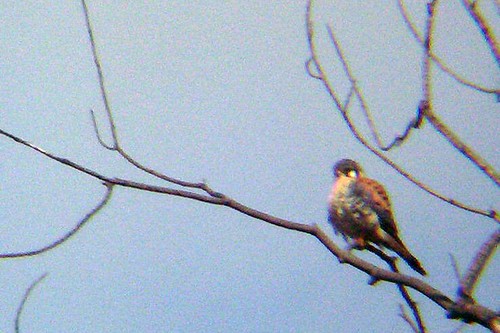Birdbranch update
I haven't seen the red-tailed hawk in the birdbranch since the day I took that photo, but I have seen a lot of the birds I now know are kestrels. Above is a picture I took of one of them on a sunny day; I was shooting through binoculars, so it's blurry, but you can see his markings quite clearly. Today, I watched through my binoculars as a kestrel sat on the birdbranch and ate a freshly caught sparrow. After a couple of minutes, another kestrel swooped out of the sky and tried to steal the carcass; there was a scuffle, and feathers and gobbets of sparrow flew about, then the interloper was rebuffed. It was very exciting, like a Hinterland Who's Who segment unfolding outside my window, without the calming flute music.



1 Comments:
in shakespeare, the kestrel is called the staniel, which means "hover-singer":
"A falcon that is known by its flight pattern is the windhover or standgale, so named because it "hovers" by facing (or standing) into the wind so that it can more easily see the movement of the voles and mice it hunts.
It's this prey for which it is also named mousehawk, although its more common names now are kestrel and staniel, both in reference to the bird's harsh cry.
Staniel developed from an OE word meaning "stone-gale", the gale here being an old word meaning to "sing" or "cry out" (similarly the nightingale is a night-singer). The OE word is also the source (by folk etymology) of the more recent standgale."
Post a Comment
<< Home